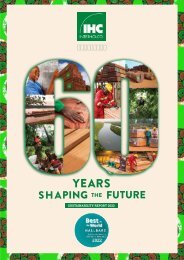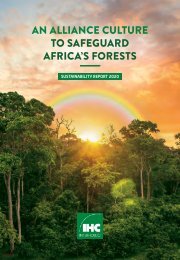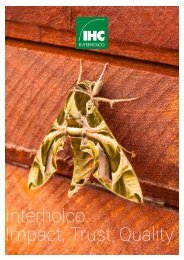Nomenclature Générale des Bois Tropicaux - 7ème édition
(english description below) Cette nomenclature est utilisée pour la mise à jour du 'Harmonized Code System' de l’Organisation Mondiale des Douanes. Dans la circulaire du 5 avril 2005, le Ministère de l’Economie, des Finances et de l’Industrie (France) reconnaît l’ATIBT comme « gardien du temple » de la nomenclature des bois tropicaux. La Commission Européenne mentionne la nomenclature de l’ATIBT comme document de référence pour la mise en œuvre du RBUE. Depuis 1954, l’ATIBT a établi et mis à jour une nomenclature des bois tropicaux faisant correspondre chaque espèce botanique avec un nom pilote reconnu internationalement. La détermination du nom pilote d’une essence est cruciale, car sa commercialisation dépend très largement de l’adoption de ce nom par le public. Le nom pilote assure la protection de l’appellation commerciale de l’essence et l’intégrité des propriétés qui lui sont attribuées, sans risque de confusion. The 1982 version of the general timber nomenclature has finally been updated as some of the 1,750 identified species, are no longer traded, while others, which were not previously included, are now on the market. The present revision has also integrated changes related to new taxonomy, in order to reflect the latest scientific developments. This Nomenclature has been used for the Harmonized Code System, updated by the World Customs Organization. The French Ministry of economy, finance and industry has given official recognition to ATIBT as the reference for the tropical timber nomenclature (NOR: PRMX0508285C of April 5th 2005). The European Commission refers to ATIBT nomenclature as a reference document for the implementation of the EUTR regulation. Since 1954, ATIBT has established and updated a nomenclature of tropical wood, linking each botanical species with an internationally recognized pilot name. A sigle wood species may have many common names; when trading across different countries, this may lead to confusion. Fixing the pilot name of a timber species is crucial, to protect the commercial denomination of the species and guarantee the veracity of the properties linked to that species, without confusion.
(english description below)
Cette nomenclature est utilisée pour la mise à jour du 'Harmonized Code System' de l’Organisation Mondiale des Douanes. Dans la circulaire du 5 avril 2005, le Ministère de l’Economie, des Finances et de l’Industrie (France) reconnaît l’ATIBT comme « gardien du temple » de la nomenclature des bois tropicaux. La Commission Européenne mentionne la nomenclature de l’ATIBT comme document de référence pour la mise en œuvre du RBUE.
Depuis 1954, l’ATIBT a établi et mis à jour une nomenclature des bois tropicaux faisant correspondre chaque espèce botanique avec un nom pilote reconnu internationalement. La détermination du nom pilote d’une essence est cruciale, car sa commercialisation dépend très largement de l’adoption de ce nom par le public. Le nom pilote assure la protection de l’appellation commerciale de l’essence et l’intégrité des propriétés qui lui sont attribuées, sans risque de confusion.
The 1982 version of the general timber nomenclature has finally been updated as some of the 1,750 identified species, are no longer traded, while others, which were not previously included, are now on the market. The present revision has also integrated changes related to new taxonomy, in order to reflect the latest scientific developments.
This Nomenclature has been used for the Harmonized Code System, updated by the World Customs Organization. The French Ministry of economy, finance and industry has given official recognition to ATIBT as the reference for the tropical timber nomenclature (NOR: PRMX0508285C of April 5th 2005). The European Commission refers to ATIBT nomenclature as a reference document for the implementation of the EUTR regulation.
Since 1954, ATIBT has established and updated a nomenclature of tropical wood, linking each botanical species with an internationally recognized pilot name. A sigle wood species may have many common names; when trading across different countries, this may lead to confusion. Fixing the pilot name of a timber species is crucial, to protect the commercial denomination of the species and guarantee the veracity of the properties linked to that species, without confusion.
Create successful ePaper yourself
Turn your PDF publications into a flip-book with our unique Google optimized e-Paper software.
Liste des noms pilotes des bois tropicaux avec renvoi aux noms scientifiques /// 53
PILOT NAME BOTANICAL NAMES COMMON NAMES
Arapari
Araracanga
Araribà
Assas
Avodiré
Awoura
Ayous
Azobé
Bacuri
Baguacù
Balata pomme
Balau, Red
Balau, Yellow
Macrolobium bifolium Pers.
Macrolobium brevense Ducke
Macrolobium multijugum Benth.
Macrolobium spp.
Aspidosperma album Benoist
Aspidosperma desmanthum Muell. Arg.
Aspidosperma p.p.
Centrolobium ochroxylon Rose
Centrolobium paraense Tul.
(Syn. Centrolobium orinocense)
Centrolobium robustum Benth.
Centrolobium spp.
Bridelia grandis Pierre
(Syn. Bridelia aubrevillei)
Turraeanthus africana Pellegr.
Julbernardia pellegriniana Troupin
(Syn. Paraberlinia bifoliolata)
Triplochiton scleroxylon K. Schum.
Lophira alata Banks
(Syn. Lophira procera)
Platonia insignis Mart.
Magnolia ovata Spreng.
(Syn. Talauma ovata)
Chrysophyllum sanguinolentum Baehni
(Syn. Ecclinusa sanguinolenta)
Shorea balangeran Burck.
Shorea collina Ridl.
Shorea guiso Blume
Shorea inaequilateralis Symington
Shorea kunstleri King
Shorea ochrophloia Symington
Shorea subgen. Rubroshorea p.p.
Shorea glauca King
Shorea laevis Ridl.
Shorea maxwelliana King
Shorea superba Symington
Shorea subgen. Eushorea p.p.
Arapari (BR)
Alcarreto (PA) ; Araracanga (BR) ; Ararauba (BR) ;
Chapel (HN) ; Chaperna (HN) ; Chichica (GT) ;
Copachi (CO) ; Gavetillo (BO) ; Jacamin (BR) ;
Kiantioutiou (GF) ; Koumanti oudou (GF) ; Kromanti
Kopi (SR) ; My Lady (BZ) ; Nielillo negro (VE) ;
Pelmax (MX) ; Pumaquiro (PE) ; Quillo caspi (CO) ;
Shibadan (GY) ; Volador (MX)
Amarillo (EC) ; Amarillo de Guayaquil (PA) ; Ararauba
(BR) ; Ararauva (BR) ; Araribà (BR) ; Balaùstre
(CO, VE) ; Cartàn (VE) ; Guayacan Hobo (CO,
VE) ; Morosimo (PY)
Assas (GA, CM) ; Tchikouebi (CI)
Apapaya (GH) ; Apaya (NG) ; Asama (CM) ; Avodiré
(CI, GH) ; Blima-Pu (LR) ; Lusamba (CD) ; M’Fube
(CD)
Awoura (GA) ; Beli (GA) ; Ekop-Beli (CM)
Arere (NG) ; Ayous (CM, GA, GQ) ; Ayus (CM,
GQ) ; Bado (CF) ; Eguess (CG) ; M’Bado (CF) ;
Obeche (NG) ; Samba (CI) ; Wawa (GH) ; Xwetin
(BJ)
Akoga (GA, GQ) ; Azobé (CI) ; Bongossi (CM) ;
Bonkole (CG) ; Eba (NG) ; Eki (BJ) ; Ekki (NG) ;
Hendui (SL) ; Kaku (GH) ; Kofyo (CF) ; Okoka
(CM)
Bacuri (BR) ; Bacuri açu (BR) ; Bacuriuba (BR) ;
Bacury (PY) ; Goelhart (SR) ; Mammea apple (GY) ;
Matazama (EC) ; Pakoeli (SR) ; Pakuri (GY) ; Parcouri
(GF) ; Ubucari (BR)
Baguacù (BR) ; Pau Pombo (BR)
Assopokballi (GY) ; Balata pomme (GF) ; Balata saignant
(GF) ; Barataballi (GY) ; Bois cochon (GF) ;
Suitiamini (SR)
Balau Laut Merah (MY) ; Balau Membatu (MY) ; Balau
Merah (ID) ; Belangeran (ID) ; Chankhau (TH) ;
Damar Laut Merah (MY) ; Empenit-Meraka (MY) ;
Gisok (PH) ; Guijo (PH) ; Makata (TH) ; Membatu
(MY) ; Red Balau (MY) ; Red Selangan Batu (MY) ;
Selangan Batu Merah (MY) ; Semayur (MY) ; Sengawan
(MY) ; Seraya Sirup (MY) ; Seri (MY)
Agelam (ID) ; Aek (TH) ; Ak (TH) ; Balau Kumus
(MY) ; Balau Simantok (MY) ; Bangkirai (ID) ; Benuas
(ID) ; Chan (TH) ; Damar Laut Kumus (MY) ;
Gisok (PH) ; Kedawang (ID) ; Kumus (ID) ; Malaykal
(PH) ; Pa-Yom Dong (TH) ; Pooti (ID) ; Sal (IN) ;
Selangan Batu (ID, MY) ; Sengkawan Darat (MY) ;
Yakal (PH)














